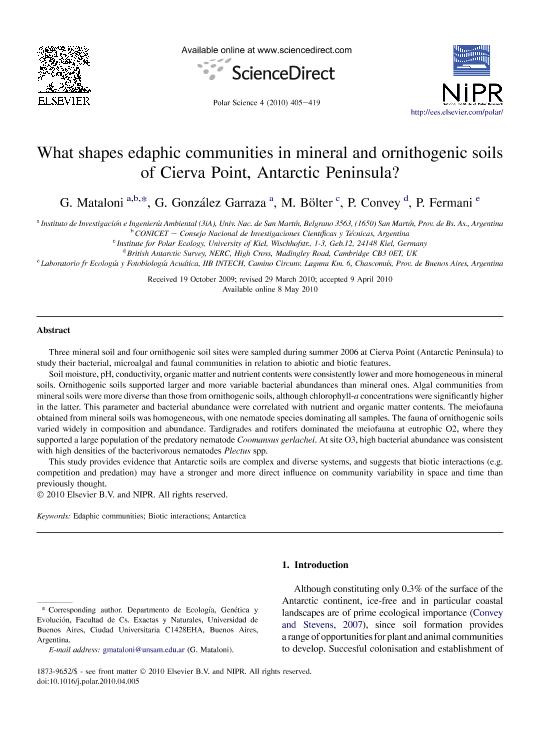Mostrar el registro sencillo del ítem
dc.contributor.author
Mataloni, Maria Gabriela

dc.contributor.author
Gonzalez Garraza, Gabriela Carolina

dc.contributor.author
Bölter, Manfred
dc.contributor.author
Convey, Peter

dc.contributor.author
Fermani, Paulina

dc.date.available
2023-03-09T12:05:27Z
dc.date.issued
2010-08
dc.identifier.citation
Mataloni, Maria Gabriela; Gonzalez Garraza, Gabriela Carolina; Bölter, Manfred; Convey, Peter; Fermani, Paulina; What shapes edaphic communities in mineral and ornithogenic soils of Cierva Point, Antarctic Peninsula?; Elsevier; Polar Science; 4; 2; 8-2010; 405-419
dc.identifier.issn
1873-9652
dc.identifier.uri
http://hdl.handle.net/11336/190020
dc.description.abstract
Three mineral soil and four ornithogenic soil sites were sampled during summer 2006 at Cierva Point (Antarctic Peninsula) to study their bacterial, microalgal and faunal communities in relation to abiotic and biotic features. Soil moisture, pH, conductivity, organic matter and nutrient contents were consistently lower and more homogeneous in mineral soils. Ornithogenic soils supported larger and more variable bacterial abundances than mineral ones. Algal communities from mineral soils were more diverse than those from ornithogenic soils, although chlorophyll- a concentrations were significantly higher in the latter. This parameter and bacterial abundance were correlated with nutrient and organic matter contents. The meiofauna obtained from mineral soils was homogeneous, with one nematode species dominating all samples. The fauna of ornithogenic soils varied widely in composition and abundance. Tardigrades and rotifers dominated the meiofauna at eutrophic O2, where they supported a large population of the predatory nematode Coomansus gerlachei. At site O3, high bacterial abundance was consistent with high densities of the bacterivorous nematodes Plectus spp.This study provides evidence that Antarctic soils are complex and diverse systems, and suggests that biotic interactions (e.g. competition and predation) may have a stronger and more direct influence on community variability in space and time than previously thought.
dc.format
application/pdf
dc.language.iso
eng
dc.publisher
Elsevier

dc.rights
info:eu-repo/semantics/openAccess
dc.rights.uri
https://creativecommons.org/licenses/by-nc-nd/2.5/ar/
dc.subject
ANTARCTICA
dc.subject
BIOTIC INTERACTIONS
dc.subject
EDAPHIC COMMUNITIES
dc.subject.classification
Ecología

dc.subject.classification
Ciencias Biológicas

dc.subject.classification
CIENCIAS NATURALES Y EXACTAS

dc.title
What shapes edaphic communities in mineral and ornithogenic soils of Cierva Point, Antarctic Peninsula?
dc.type
info:eu-repo/semantics/article
dc.type
info:ar-repo/semantics/artículo
dc.type
info:eu-repo/semantics/publishedVersion
dc.date.updated
2023-03-08T13:01:23Z
dc.journal.volume
4
dc.journal.number
2
dc.journal.pagination
405-419
dc.journal.pais
Países Bajos

dc.journal.ciudad
Ámsterdam
dc.description.fil
Fil: Mataloni, Maria Gabriela. Universidad Nacional de San Martín. Instituto de Investigación e Ingeniería Ambiental. - Consejo Nacional de Investigaciones Científicas y Técnicas. Oficina de Coordinación Administrativa Parque Centenario. Instituto de Investigación e Ingeniería Ambiental; Argentina
dc.description.fil
Fil: Gonzalez Garraza, Gabriela Carolina. Universidad Nacional de San Martín. Instituto de Investigación e Ingeniería Ambiental. - Consejo Nacional de Investigaciones Científicas y Técnicas. Oficina de Coordinación Administrativa Parque Centenario. Instituto de Investigación e Ingeniería Ambiental; Argentina
dc.description.fil
Fil: Bölter, Manfred. Christian Albrechts Universitat Zu Kiel; Alemania
dc.description.fil
Fil: Convey, Peter. British Antarctic Survey; Reino Unido
dc.description.fil
Fil: Fermani, Paulina. Universidad Nacional de San Martin. Instituto Tecnológico de Chascomús - Consejo Nacional de Investigaciones Científicas y Técnicas. Centro Científico Tecnológico Conicet - La Plata. Instituto Tecnológico de Chascomús; Argentina
dc.journal.title
Polar Science
dc.relation.alternativeid
info:eu-repo/semantics/altIdentifier/url/https://www.sciencedirect.com/science/article/pii/S1873965210000332
dc.relation.alternativeid
info:eu-repo/semantics/altIdentifier/doi/https://doi.org/10.1016/j.polar.2010.04.005
Archivos asociados
